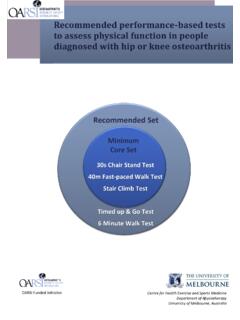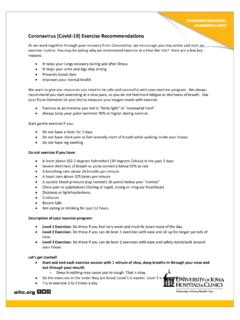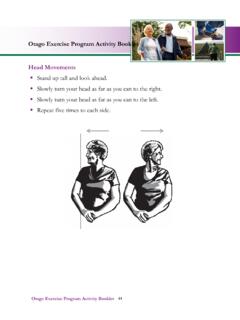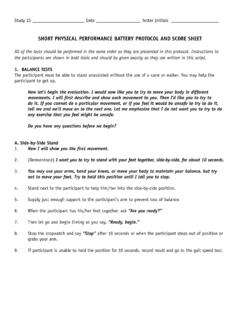Transcription of 6-Minute Walk Test Protocol - University of Toronto
1 IWalk Guide Online Resources 7. 6-Minute walk Test Protocol University of Toronto , Toronto , Canada 1 6-Minute walk Test Protocol Equipment: 6 MWT Protocol and Data Collection and Goal Setting Form on clipboard Measured and marked 30-metre walkway Heart rate (HR) monitor Blood pressure (BP) cuff Rating of Perceived Exertion Scale 3-4 armchairs (depending on patient s functional level) 2 pylons to mark the ends of the walkway Stopwatch* Length counter* Pen, piece of tape or beanbag to mark where the patient stops Transfer belt (if needed) Access to a telephone in case of an emergency An emergency plan *Not needed if using the iWalkAssess smartphone application.
2 Patient Preparation: Patients should: 1. Wear comfortable clothing. 2. Wear appropriate shoes for walking. 3. Wear corrective eyewear (if applicable). 4. Use their presently used walking aids and orthoses during the test. 5. Take their medications as usual. 6. Not have exercised vigorously within 2 hours of beginning the test. Test Set-Up: Position a chair at each end of the 30-metre walkway and one or two chairs along the walkway as appropriate. Place a pylon inside each end point of the walkway. iWalk Guide Online Resources 7. 6-Minute walk Test Protocol University of Toronto , Toronto , Canada 2 Screening for Contraindications: Check the box if any of the following relative contraindications is present.
3 Consult with a physician prior to proceeding with the test if one or more is checked: Resting HR > 120 bpm Resting HR < 60 bpm Resting systolic BP 160 mmHg Resting diastolic BP 100 mm Hg Left main coronary stenosis or its equivalent Moderate stenotic valvular heart disease High-degree atrioventricular block Hypertrophic cardiomyopathy Significant pulmonary hypertension Advanced or complicated pregnancy Electrolyte abnormalities Orthopedic impairment that prevents walking Complete for patients with stable exertional angina only: Patients with stable exertional angina have NOT taken anti-angina medication. Rescue nitrate medication is NOT readily available.
4 Screening of relative contraindications completed Check the box if any of the following absolute contraindications is present. Do not conduct the test if any one of the following is present: Myocardial infarction within 3-5 days Unstable angina Uncontrolled arrhythmias causing symptoms Syncope Active endocarditis Acute myocarditis or pericarditis Symptomatic severe aortic stenosis Uncontrolled heart failure Acute pulmonary embolus or pulmonary infarction Thrombosis of lower extremities Suspected dissecting aneurysm Uncontrolled asthma Pulmonary edema Oxygen saturation 85% on room air at rest* Acute respiratory failure Acute non-cardiopulmonary disorder that may affect exercise performance or be aggravated by exercise ( infection, renal failure, thyrotoxicosis)
5 Mental impairment leading to inability to cooperate Screening of absolute contraindications completed * If this occurs, provide patient with supplemental oxygen. If a patient has a respiratory condition, oxygen saturation should be monitored throughout the 6 MWT and the test stopped if the level falls below 80%. iWalk Guide Online Resources 7. 6-Minute walk Test Protocol University of Toronto , Toronto , Canada 3 Testing: Note: The patient does not need to be able to walk continuously for 6 minutes to perform the test. The test can be conducted to provide a baseline for comparing future performance. 1. While the patient is seated and at rest, measure and document perceived exertion, HR, and BP.
6 Clients should be seated comfortably for a few minutes with legs uncrossed and feet resting firmly on the floor with back supported before taking HR and BP. Take BP using the unaffected arm, supporting the forearm at the level of the heart. 2. Put a transfer belt on the patient if appropriate. 3. The test should be performed once. The patient should not practice the test beforehand. 4. The evaluator should have hands free. A stopwatch can be worn around the neck with a mechanical length counter attached to the stopwatch string. Alternately, a smartphone can be worn in a lanyard around the neck. 5. With the patient seated at the start end of the walkway, say: The aim of this test is to walk as far as possible for 6 minutes.
7 You will walk along this hallway between the pylons as many times as you can in 6 minutes. I will let you know as each minute goes past, and then at 6 minutes I will ask you to stop where you are. 6 minutes is a long time to walk , so you will be exerting yourself. You are permitted to slow down, to stop, and to rest as necessary, but please start walking again as soon as you are able. Please do not talk during the test unless you have a problem, are feeling unwell or need to tell me you need a rest. You must let me know if you have any chest pain or dizziness. Now I m going to show you. Therapist demonstrates walking 30 metres and back. 6. Position the patient at the starting point and stand on the patient s affected side.
8 Provide the minimum amount of manual assistance necessary to maintain patient safety. Say: Remember that the objective is to walk AS FAR AS POSSIBLE for 6 minutes, but don t run or jog. Do you have any questions? When you are ready, please begin. 7. Start timing once the patient starts walking. walk slightly behind the patient so as not to pace the patient. Provide physical assistance ( , for balance or weight-shifting) if necessary. 8. The evaluator must watch the participant closely and provide close supervision. Immediately stop the test if the patient exhibits ANY one of the following: - Chest pain - Light-headedness - Severe dyspnea (shortness of breath) - Confusion - Leg cramps - Cyanosis (blue or grey skin colour) - Staggering - Nausea - Diaphoresis (excessive perspiration or sweating) - Excessive fatigue - Pale or ashen appearance - Facial expression signifying distress If the test is stopped for any of the above reasons, the patient should sit or lie down.
9 If in the hospital, the patient s nurse should be immediately notified. The evaluator should assess HR, BP and blood oxygenation. iWalk Guide Online Resources 7. 6-Minute walk Test Protocol University of Toronto , Toronto , Canada 4 9. If the patient chooses to sit down or lean against the wall during the test to rest, continue timing. Every 30 seconds, say: Please start walking again whenever you feel able. 10. The patient should not talk or be distracted during the test. The evaluator should provide the following standardized encouragement in even tones during the test: At 1 minute You are doing well. You have 5 minutes to go. At 2 minutes Keep up the good work.
10 You have 4 minutes to go. At 3 minutes You are doing well. You are halfway. At 4 minutes Keep up the good work. You have only 2 minutes left. At 5 minutes You are doing well. You have only 1 minute to go. 11. Count each length using the length counter or the iWalkAssess smartphone application. 12. If the patient chooses to stop the test before 6 minutes have passed, mark the exact spot where the patient stopped by placing a pen, piece of tape or bean bag on the floor. Assist the patient to the nearest chair. Record the time stopped, the reason for stopping, and the distance walked. 13. When 6 minutes has passed, tell the patient Please stop where you are.







